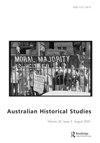Old Dead Trees and Young Trees Green: The Cambridge Legal History of Australia
IF 0.6
3区 历史学
Q1 HISTORY
引用次数: 0
Abstract
Click to increase image sizeClick to decrease image size Notes1 Peter Cane, Lisa Ford and Mark McMillan, eds, The Cambridge Legal History of Australia (Cambridge: Cambridge University Press, 2022).2 Markus D. Dubber and Christopher Tomlins, eds, The Oxford Handbook of Legal History (Oxford: Oxford University Press, 2018); Heikki Pihlajamäki, Markus D. Dubber and Mark Godfery, eds, The Oxford Handbook of European Legal History (Oxford: Oxford University Press, 2018).3 See Keith Pickens, ‘The Writing of New Zealand History: A Kuhnian Perspective’, Historical Studies 17, no. 68 (1977): 384. Keith Sinclair, A History of New Zealand (Harmondsworth: Penguin, 1959) is essentially Turnerian (stressing the frontier and the local creation of culture and identity); W.H. Oliver, The Story of New Zealand (London: Faber and Faber, 1960) is essentially Hartzian.4 Patricia Nelson Limerick, The Legacy of Conquest: The Unbroken Past of the American West (New York: Norton & Company, 1988). Nevertheless the frontier thesis remains alive and well, and numerous distinguished books by prominent American and Canadian historians have been published recently which continue to utilise the concept of the frontier.5 David Lieberman, ‘English Legal Culture in the Late Eighteenth Century: Institutions and Values’, in The Cambridge Legal History of Australia, 40–60.6 See, for example, Ion Idriess, Our Living Stone Age (Melbourne: Angus and Robertson, 1963).7 B. Spencer and F.J. Gillen, The Arunta: A Study of Stone Age People (London: Macmillan, 1927), vii. This book correlates with the evolutionist phase in the history of cultural anthropology, which has long been supplanted by the functionalist school of Malinowski and others as well as by the style of anthropology pioneered by Franz Boas in the USA. See generally G.W. Stocking, After Tylor: British Social Anthropology 1888–1951 (Madison: University of Wisconsin Press, 1995).8 See Mike Smith, The Archaeology of Australia’s Deserts (Cambridge: Cambridge University Press, 2013), 212–67. The modern emphasis is to understand Aboriginal rock art as a product of complex cultural traditions unique to Australia and to discard synchronic and diachronic comparisons.9 Ibid.10 Coel Kirby, ‘Australia and the World’, in The Cambridge Legal History of Australia, 281–302.11 Ibid., 282.12 See e.g. John Hirst, Freedom on the Fatal Shore: Australia’s First Colony (Melbourne: Black Inc., 2008). This book is a consolidation of the same author’s Convict Society and Its Enemies (1983) and The Strange Birth of Colonial Democracy (1988).13 Bruce Kercher, ‘Colonial Settlement to Colony’, in The Cambridge Legal History of Australia, 87–107.14 Ibid., 88.15 See Catherine Hall, Civilising Subjects: Metropole and Colony in the British Imagination (Cambridge: Polity, 2002).16 Amanda Nettelbeck, ‘Protection Regimes’, in The Cambridge Legal History of Australia, 482–501.17 Ibid., 499.18 See John H. Langbein, The Origins of Adversary Criminal Trial (Oxford: Oxford University Press, 2003).19 See Richard Hill, The Colonial Frontier Tamed: New Zealand Policing 1867–1886 (Wellington: Historical Branch, Department of Internal Affairs and GP Books, 1989).20 Mark Finnane, ‘Indigenous Peoples and Settler Criminal Law’, in The Cambridge Legal History of Australia, 629–50, 629.21 Ibid., 650.22 Diane Kirkby, ‘Labour Law’, in The Cambridge Legal History of Australia, 671–92.23 Ibid., 688–9.24 Bruce H. Mann, ‘The Transformation of Law and Economy in Early America’, in The Cambridge History of Law in America, vol. I, Early America (1850–1815), eds Michael Grossberg and Christopher Tomlins (Cambridge: Cambridge University Press, 2008), 365–99, 377.25 On the American phase of British transportation, see A. Roger Ekirch, Bound for America: Transportation of British Convicts to the Colonies, 1718–1775 (Oxford: Clarendon Press, 1987). On the various forms of free and unfree migration to, and of labour in, colonial British North America, see Christopher Tomlins, Freedom Bound: Law, Labour and Civic Identity in Colonizing English America, 1580–1865 (Cambridge: Cambridge University Press, 2010). Tomlins argues, in an extended discussion, that the boundaries between ‘free’ and ‘unfree’ labour in colonial British North America were highly permeable; I can see no reason why the same could not be said of colonial Australia, which received not only convicts but also enslaved Pacific islanders, sent there by means of what is euphemistically referred to as the Pacific ‘labour trade’. I may have missed it, but I couldn’t find anything about the latter in The Cambridge Legal History of Australia; on New Caledonia as France’s penal colony, see Louis-José Barbançon, L’Archipel des Forçats (Paris: Presses Universitaires de Septentrion, Paris, 2003), 15.26 Shino Konishi, ‘Reckoning with the Past’, in The Cambridge Legal History of Australia, 740–64.27 Nicole Watson, ‘Indigenous Legal Traditions and Australian Legal Education’, in The Cambridge Legal History of Australia, 721–39.28 See further, Ron Harris, ‘Is It Time for a Non Euro-American Legal History?’, The American Journal of Legal History 56, no. 1 (2016): 60.29 Kathy Bowrey, ‘Place and Race in Australian Copyright Law: May Gibbs’s and Albert Namatjira's Copyright’, in The Cambridge Legal History of Australia, 693–718.30 Bronislaw Malinowski, Argonauts of the Western Pacific (New York: E.P. Dutton & Co, 1961; originally published 1922).老死树与绿嫩树:剑桥澳大利亚法律史
注1彼得·凯恩、丽莎·福特和马克·麦克米兰主编,《澳大利亚剑桥法律史》(剑桥:剑桥大学出版社,2022年)马库斯D.杜伯和克里斯托弗汤姆林斯,编辑,《牛津法律史手册》(牛津:牛津大学出版社,2018);2 . Heikki Pihlajamäki, Markus D. Dubber和Mark Godfery主编,《欧洲法律史牛津手册》(牛津:牛津大学出版社,2018)见基思·皮肯斯,“新西兰历史的写作:库恩主义的视角”,《历史研究》17期,第17期。68(1977): 384。基思·辛克莱的《新西兰史》(哈蒙兹沃斯出版社:企鹅出版社,1959年)本质上是特纳式的(强调边疆和当地创造的文化和身份);w·h·奥利弗的《新西兰的故事》(伦敦:费伯与费伯出版社,1960年)本质上是哈兹安的。帕特里夏·纳尔逊·利默里克的《征服的遗产:美国西部完整的过去》(纽约:诺顿出版社,1988年)。尽管如此,边疆理论仍然存在,而且很好,美国和加拿大著名的历史学家最近出版了许多杰出的书籍,继续利用边疆的概念大卫·利伯曼,《18世纪晚期的英国法律文化:制度与价值》,载于《剑桥澳大利亚法律史》,第40-60.6页。例如,参见Ion Idriess,《我们的活石器时代》(墨尔本:Angus and Robertson出版社,1963)B. Spencer和F.J. Gillen, The Arunta: A Study of Stone Age People (London: Macmillan, 1927), vii。这本书与文化人类学历史上的进化主义阶段有关,这一阶段早已被马林诺夫斯基等人的功能主义学派以及美国博阿斯开创的人类学风格所取代。7 .参见G.W. Stocking,《泰勒之后:1888-1951年英国社会人类学》(麦迪逊:威斯康星大学出版社,1995年)见迈克·史密斯:《澳大利亚沙漠考古》(剑桥:剑桥大学出版社,2013),212-67页。现代的重点是把土著岩石艺术理解为澳大利亚独特的复杂文化传统的产物,抛弃共时性和历时性的比较同上10 Coel Kirby,“澳大利亚与世界”,载于《剑桥澳大利亚法律史》,281-302.11同上,282.12参见John Hirst,《致命海岸上的自由:澳大利亚的第一个殖民地》(墨尔本:Black Inc., 2008)。这本书是同一作者的《罪犯社会及其敌人》(1983)和《殖民地民主的奇怪诞生》(1988)的综合16 . Bruce Kercher,“从殖民地到殖民地”,载于《剑桥澳大利亚法律史》,87-107.14,同上,88.15见Catherine Hall,《文明主体:英国想象中的大都市和殖民地》(Cambridge: Polity, 2002)19 . Amanda Nettelbeck,《保护制度》,载于《剑桥澳大利亚法律史》,第482-501.17页,同上,第499.18页。见John H. Langbein,《敌对刑事审判的起源》(牛津:牛津大学出版社,2003年)见理查德·希尔,《驯服的殖民边境:1867-1886年的新西兰警务》(惠灵顿:内务部历史分部和GP出版社,1989年)Mark Finnane,“土著居民和定居者刑法”,载于《剑桥澳大利亚法律史》,629 - 50,629.21同上,650.22 Diane Kirkby,“劳动法”,载于《剑桥澳大利亚法律史》,671-92.23同上,688-9.24 Bruce H. Mann,“早期美国法律和经济的转型”,载于《剑桥美国法律史》,卷1,早期美国(1850-1815),编辑Michael Grossberg和Christopher Tomlins(剑桥:剑桥大学出版社,2008),365-99,377.25关于英国运输的美国阶段,见A.罗杰·埃克里奇,开往美国:英国囚犯到殖民地的运输,1718-1775(牛津:克拉伦登出版社,1987)。关于各种形式的自由和不自由移民,以及在英属北美殖民地的劳动力,见克里斯托弗·汤姆林斯,自由约束:法律,劳工和公民身份在殖民英属美洲,1580-1865(剑桥:剑桥大学出版社,2010)。汤姆林斯在一篇延伸的讨论中认为,在英属北美殖民地,“自由”和“不自由”劳动力之间的界限是高度可渗透的;我看不出为什么殖民时期的澳大利亚不能这样说,它不仅接收罪犯,还接收被奴役的太平洋岛民,通过委婉地称为太平洋“劳工贸易”的方式被送到那里。我可能错过了,但我在《剑桥澳大利亚法律史》中找不到关于后者的任何内容;关于新喀里多尼亚作为法国的刑罚殖民地,见louis - jossore barbanon, L ' archipel des forats(巴黎:出版社de Septentrion,巴黎,2003),15.26筱野小西,“与过去的计算”,澳大利亚剑桥法律史,740-64。
本文章由计算机程序翻译,如有差异,请以英文原文为准。
求助全文
约1分钟内获得全文
求助全文
来源期刊

AUSTRALIAN HISTORICAL STUDIES
HISTORY-
CiteScore
0.70
自引率
16.70%
发文量
86
期刊介绍:
Australian Historical Studies is a refereed journal dealing with Australian, New Zealand and Pacific regional issues. The journal is concerned with aspects of the Australian past in all its forms: heritage and conservation, archaeology, visual display in museums and galleries, oral history, family history, and histories of place. It is published in March, June and September each year.
 求助内容:
求助内容: 应助结果提醒方式:
应助结果提醒方式:


